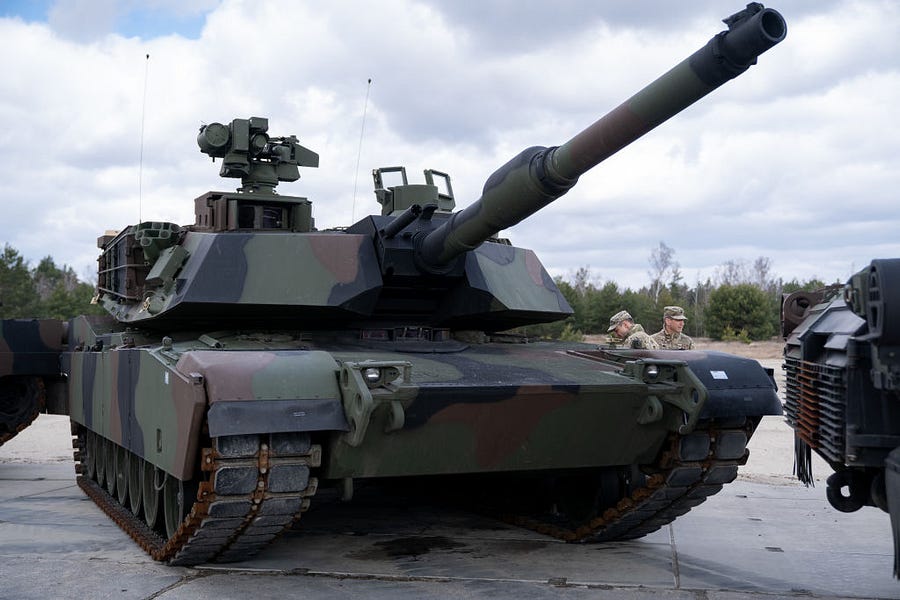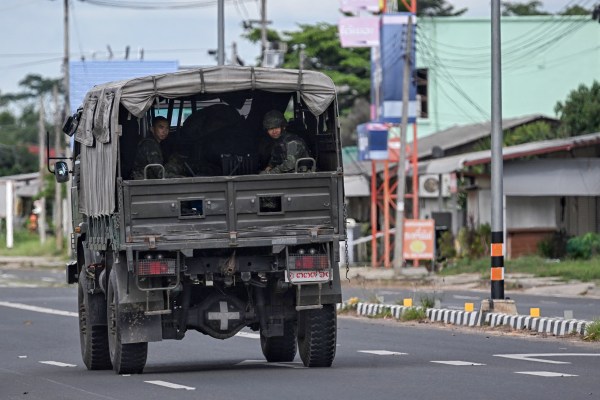“Why do we have more tanks than drones?”
So asked the chairman of the House Armed Services Committee, Rep. Adam Smith, and sources say that Sen. Jack Reed, chairman of the Senate Armed Services Committee, agrees. “I mean, tanks are not as useful as they used to be,” continued Smith at a late March panel hearing. “Drones are a lot more useful. … We need to modernize our approach to warfare technology. It’s all about information and survivability now.”
Thanks to the Biden administration’s insufficient defense budget request and the Army’s political myopia, the two chairmen may get their way. Rather than propose a defense budget in line with U.S. national security strategy and the realities of current inflation rates, the administration and the service dramatically reduced funding in the 2023 Pentagon proposal for the Army’s M1 Abrams tank production from what had been 165 tanks in 2020 to only 22 in 2023. Why did the Army cut its tank production? It’s counting on Congress to increase procurement and, as it has in the past, save the service from itself.
Four months ago, this might have been a reasonable gamble; it has been clear from the start that Congress would increase the defense topline budget and the M1 program has long enjoyed broad congressional support. But with escalating worries about China’s rise and frustration with the languid pace of Pentagon modernization and lack of innovation—“The Pentagon is not innovating as fast as they need to. We’re going to keep putting pressure on them,” says Smith—the Army might well be hoisted by its own too-clever petard.
Tanks have long been targets of derision for supposed defense innovators and “tranformationalists.” Funeral orations for the tank and heavy armored vehicles in general have been declaimed for at least 50 years. These began in the wake of the October 1973 war between Israel and Arab states, when the Egyptian army first employed substantial numbers of Soviet-made “Sagger” guided anti-tank missiles to shocking initial effect—the Israelis lost 100 tanks on the first day of the war. Even the one-sided annihilation of much of the Iraqi Republican Guard at the climax of Operation Desert Storm could be spun as “history’s last tank battle,” while others argued that the “shock and awe” of the preceding extended air campaign had won the war already.
The Ukraine war has seemed equally shocking, as Chairman Smith’s comments reveal. “We’ve seen the Russians bogged down. That’s because their columns have been attacked and attacked by drones.” Indeed, video footage of backed up Russian vehicles exploding, tank turrets launched hundreds of feet into the air amid spectacular fireballs, have encapsulated the power of the Ukrainian repulse of the Russian invaders. So, too, have clips of Ukrainian infantry armed with American Javelin, British “Next Generation Light Anti-tank Weapon,” or NLAW, and other missiles. As after the October 1973 war, the low cost of defensive systems compares favorably with the expense of the tank, most especially if the tank is in the hands of an incompetent invader.
But in Ukraine today as in the Sinai in 1973, these hot-take conclusions will not withstand closer scrutiny. Once the U.S. Army got down to a detailed analysis of the Arab-Israeli war, a more complex picture emerged. The initial Israeli defeats—and the following larger defeat of the Syrian army on the Golan Heights that ended the conflict—were both revealed as failures of “combined arms” operations in which multiple combat systems, including aircraft as well as tanks, infantry, artillery and air defenses are coordinated to produce a whole greater than the sum of the parts. Neither the tank nor the anti-tank missile was a silver bullet in itself, and because the Israel Defense Force grasped this fact and adapted its tactics more rapidly than the Egyptians or Syrians, they reversed the course of the war and earned a lasting victory, occupying the Golan Heights to this day.
While it will take a similarly deep dive to derive truly useful lessons from the Ukraine war, it is already apparent that there’s more to the story than Smith’s drones-versus-tanks version. To begin with, the efficacy of unmanned reconnaissance and attack systems is as much a testament to the shortcomings of air defense (on both sides) as the drones’ “ability to get out there and not be seen,” as the congressman believes. The Russians assumed they would quickly establish air supremacy in Ukraine and have, in Putin’s previous adventures in Chechnya, Georgia, Syria, and Ukraine in 2014, not been forced to fight in contested airspace. And as the Ukrainians have received supplies of U.S. Stinger and other advanced Western man-portable air defense systems, they have employed them against Russian drones. The seeming dominance of the drone is a product of the unique circumstances of this war.
Likewise, the miseries of Russian tankers are exacerbated by the particulars of the case. To begin with, Russian armor is poorly designed, poorly organized—especially for use in urban combat—and poorly maintained. Compared to current-generation Western tanks, even the most modern Russian designs lack protection, lack sophisticated electronic targeting or defensive systems, and much else. Contrary to the myths of the Red Army, Putin’s army has skimped on manpower in almost every way: Its tanks have three crew members rather than four (and must frequently be commanded by junior officers rather than experienced NCOs); its tank platoons are three vehicles rather than four (a difference magnified in close-quarter, city-street engagements) and its companies and battalions lack supporting dismounted infantry to protect against Ukrainian scouts and anti-armor ambushes. The vaunted Russian “battalion tactical group” is, as the war makes plain, essentially designed as an artillery formation inside a thin protective shell of tanks and infantry, lacking much organic logistical sustainment. It is not meant for operational-scale maneuvers far distant from railroad supply. What we see now in the Donbas—massive barrages followed by incremental gains at a high cost in casualties—is what the Russian army is capable of doing.
To their credit—strategically, operationally, tactically, and morally—and because this is the foe they have been fighting since 2014, the Ukrainians could stymie the thrusts toward Kyiv and Kharkiv. They are likewise exacting a tremendous price for the small gains the Russians are achieving in the Donbas. Yet, to truly tip the balance, to restore the status quo of February or set conditions for the restoration of full territorial sovereignty, simply ambushing Russian tanks will not suffice because the battle lines that are forming resemble World War I trench warfare rather than the maneuver warfare of World War II. Tanks provide the entire combined arms team with mobile protected firepower, and tanks enable maneuver warfare when they are in the hands of competent leaders.
So, the Ukrainian army likely will need more than drones, long-range artillery and skilled infantry anti-armor teams, although they need those as well. Unless there is a precipitate collapse of the Russian army—possible but perhaps not probable and certainly not predictable—they will need to win at least local air superiority and sufficient mobile, protected firepower to penetrate Russian defenses in order to gain and hold ground.
Thus it should come as no surprise that the Ukrainians, and most of Eastern Europe, are desperate to replace their hodgepodge fleet of old Soviet T-72s with current generation Western tanks and especially U.S. Abrams. Spain has agreed to give the Ukrainians 40 older variants of the German Leopard II, although, all too predictably, the Germans may not assent. That would be a big step; the Leopard is a very fine design, but Germany no longer makes them and has neglected to continuously upgrade as aggressively or thoroughly as the U.S. Army has done with the M1, which is about to be upgraded to a fourth “service-extension” edition of what was already an improved M1A2. The Abrams remains the most powerful land combat system and, in the context of well-executed combined arms operations, can be a decisive platform not only for the United States but its allies.
As we look at the Ukraine war dragging on, rapidly consumed items such as Stingers and Javelin are going to take years to replenish, a fact driven by the Army’s feast-and-famine cycle of acquisition. While the consequences in peacetime appear manageable, this procurement pattern hollows the industrial base and supply chain not only to provide American soldiers with what they need but limiting our ability to act as the “arsenal of democracy” for others. The Abrams tank is going to be in the hands of U.S. and NATO members for decades to come; without an active procurement program, the supply base will wither away and this capability will not last past the first days of any major war. Additionally, the M1 plant in Lima, Ohio, is the only facility—and employs the only workforce—in the Western world capable of producing such a vehicle in a timely way. Like the Germans, the British have been forced to close their tank line. With reduced production, the highly skilled workforce will go to other jobs, never to return.
The M1, with all its upgrades, is now pushing 80 tons, or about 20 tons more than Russian-made models. It’s powered by a gas turbine engine that both sucks jet fuel at three gallons per mile but moves the behemoth at a 60-mile-per-hour dash speed. It is protected with a classified mix of armor inserts that are constantly improved, and the M1 can, while traveling at speed, fire a 120-millimeter, depleted-uranium round that can destroy any target within three miles with a single shot. This is more like a fighter airplane than a tractor. It also could and should be common currency across NATO’s “eastern front.” Poland will acquire 300 Abrams, a deal that permitted them to ship their old T-72s to Ukraine. The U.S. Army has been rebuilding its stocks of prepositioned heavy forces in Europe and is likely to add more Abrams in the theater. As the Army deployed into Europe at the beginning of this war, it was the armored brigades that provided the greatest assurance to our Eastern European NATO allies, but these units are now stretched thin and three brigades is hardly a massive force. A protracted war in Ukraine means the Army is likely to need to create more of these armored units—producing the tanks now is the only way to have them when we need them.
While not even the M1 can last forever, the need for a similar capability will endure. And the real lesson of the Ukraine conflict should be that war remains an unpredictable affair, one that inevitably gives the lie to overly precise predictions of future combat. Every war is different. We often castigate our generals for refighting the last war rather than preparing for the future. As the former Secretary of Defense Robert Gates says, we get the future wrong 100 percent of the time. The American military, with global responsibilities, needs a full complement of military capabilities that work together to provide multiple dilemmas to our adversaries. Terminating this sole remaining tank program in the midst of a raging land war in central Europe—and with a Russian leadership mesmerized by a vision of imperial restoration—is an “innovation” to avoid.
Giselle Donnelly is a senior fellow in foreign and defense policy studies at the American Enterprise Institute. Maj. Gen. John Ferrari, U.S. Army (ret.), is a visiting fellow at AEI and is the former director of program analysis and evaluation for the U.S. Army.






Please note that we at The Dispatch hold ourselves, our work, and our commenters to a higher standard than other places on the internet. We welcome comments that foster genuine debate or discussion—including comments critical of us or our work—but responses that include ad hominem attacks on fellow Dispatch members or are intended to stoke fear and anger may be moderated.
With your membership, you only have the ability to comment on The Morning Dispatch articles. Consider upgrading to join the conversation everywhere.